Of all the weapons that have entered service over the last 50 years, none have had a greater impact on naval warfare than the Tomahawk cruise missile. This weapon has given destroyers and submarines the ability to strike targets far inland, a capability that was previously the exclusive preserve of the carriers. This dispersion of strike power has proved vital to the surface and subsurface navies in the post-Cold War world, and has given the President new tools for projecting American power.
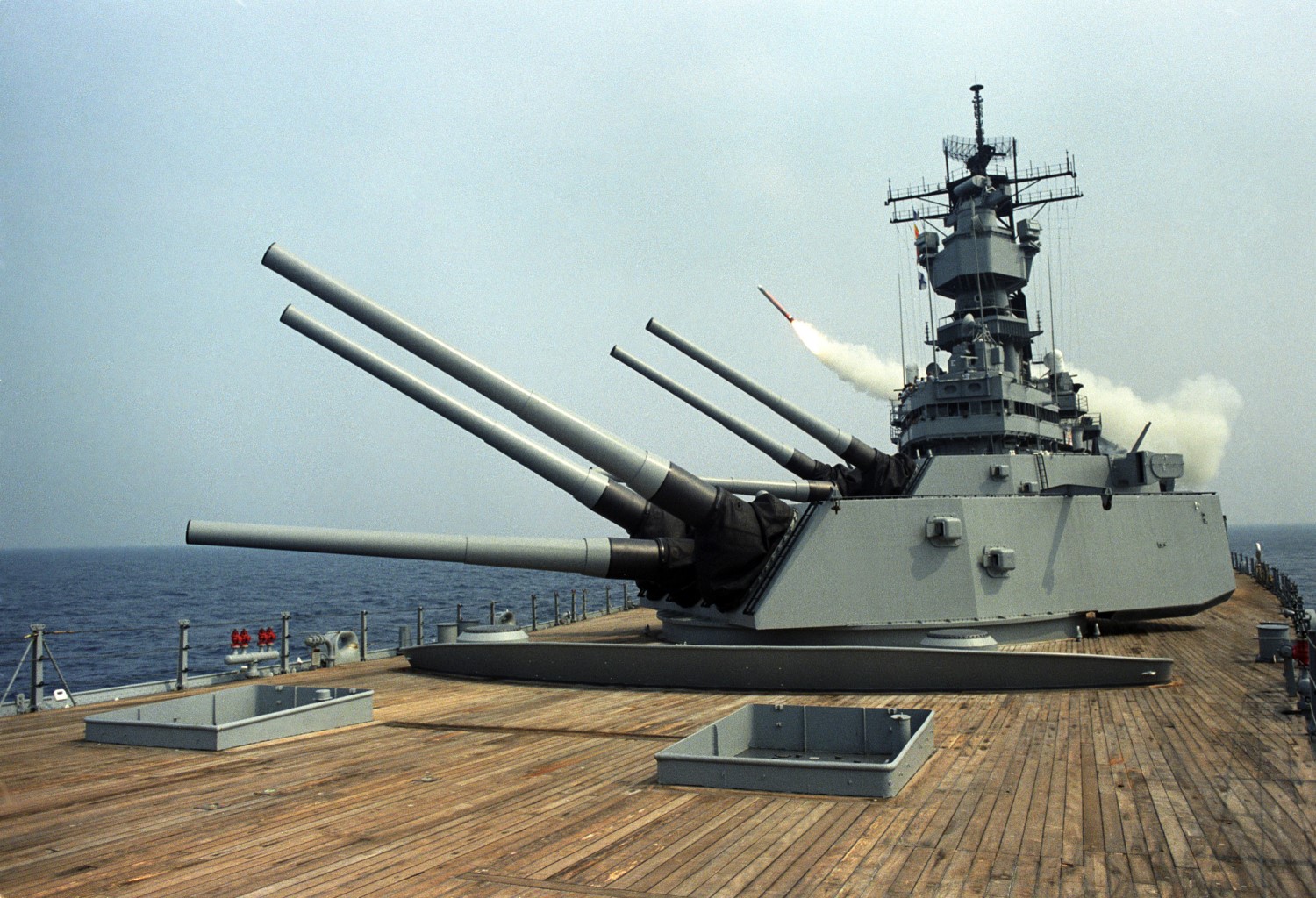
Iowa launches a Tomahawk
Tomahawk originated in the early 1970s, shortly after the signing of the Strategic Arms Limitation Treaty (SALT I), which didn't cover submarine-launched cruise missiles. The basic idea of such a missile wasn't new. The JB-2 Loon had been test-fired from a couple of submarines in the years after WWII, and the US had followed it with Regulus, which was fitted to five submarines, which conducted deterrent patrols in the Pacific from 1959 to 1964. However, Regulus was large enough that even its specialized submarines could only carry 2-5 missiles and it had to be launched from the surface, so it was rapidly phased out and replaced by Polaris. But in the aftermath of SALT I, which limited most types of nuclear weapons but not cruise missiles, the time seemed ripe to try again. The new weapon would have to fit into a standard 21" torpedo tube and be launched from underwater, giving the fleet's attack submarines a strategic strike capability against the Soviet Union.
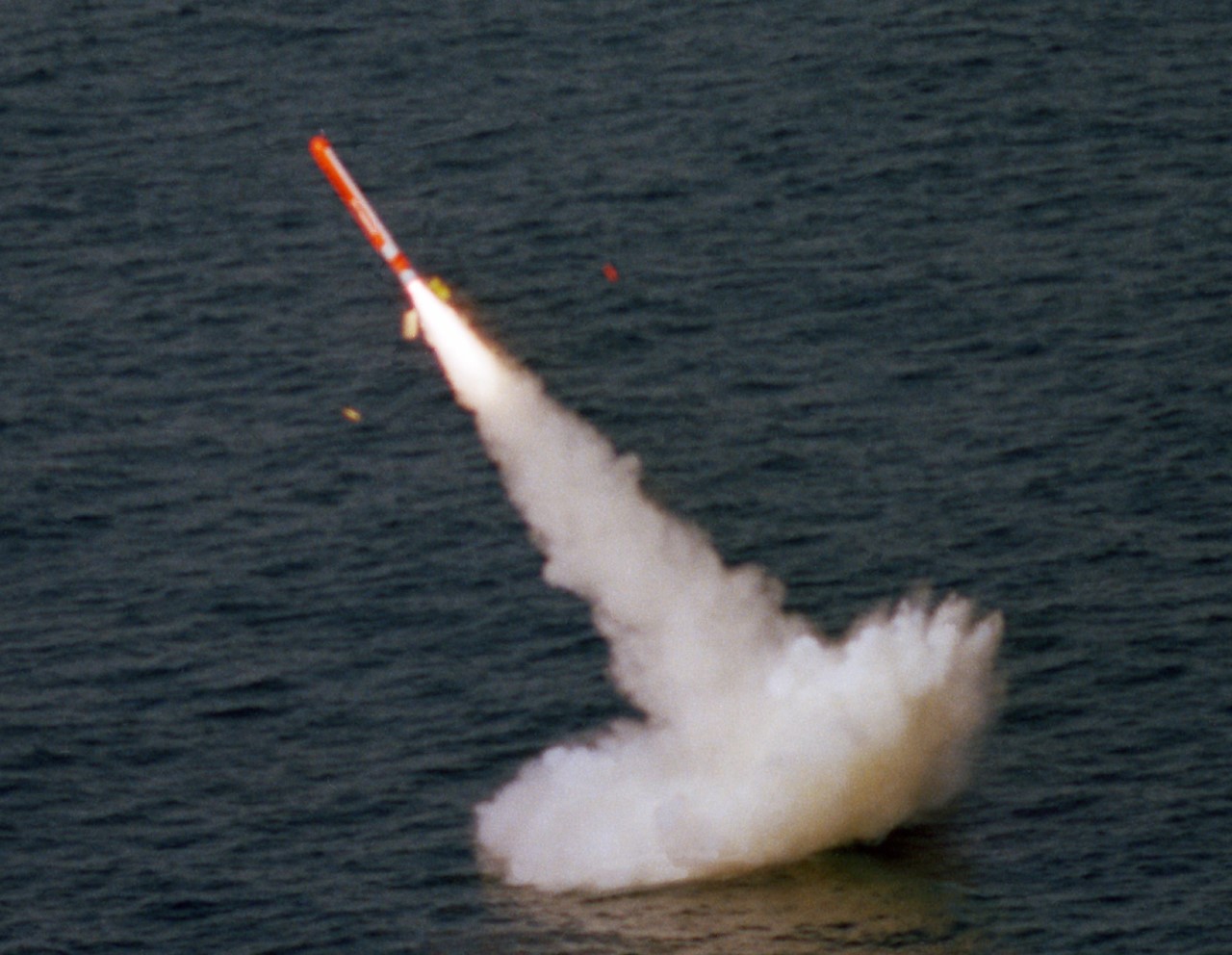
A Tomahawk breaks the surface after being launched from a torpedo tube
The program moved quickly, with General Dynamics and LTV being awarded contracts for the BGM-109 and BGM-110 respectively. Guidance and engine development were undertaken independently, with cooperation from the Air Force, which was also seeking to develop a new cruise missile for its bombers. In 1977, General Dynamics won the competition, which by this point had broadened to include not only the nuclear land-attack missile, subsequently called TLAM-N (Tomahawk Land Attack Missile-Nuclear), but also an anti-ship version (TASM, Tomahawk Anti-Ship Missile) and a conventional land-attack version (TLAM-C). Also added to the program were versions of the missile designed to be launched from surface ships, and from vertical tubes that would be fitted to future submarines. By late 1983, TASM entered service onboard the submarine Atlanta, followed by TLAM-N the next June. Surface ships followed swiftly, with the first operational missiles aboard the battleship New Jersey. Tomahawk was a key driver of the reactivation of the Iowa class battleships, with Iowa following her sister into service in 1984. The conventional missiles took a bit longer to reach operational status, but both unitary warhead and submunition variants were in service by 1988. They were joined by the BGM-109G GLCM, a ground-launched nuclear variant that bolstered NATO's intermediate-range nuclear forces from 1983.1
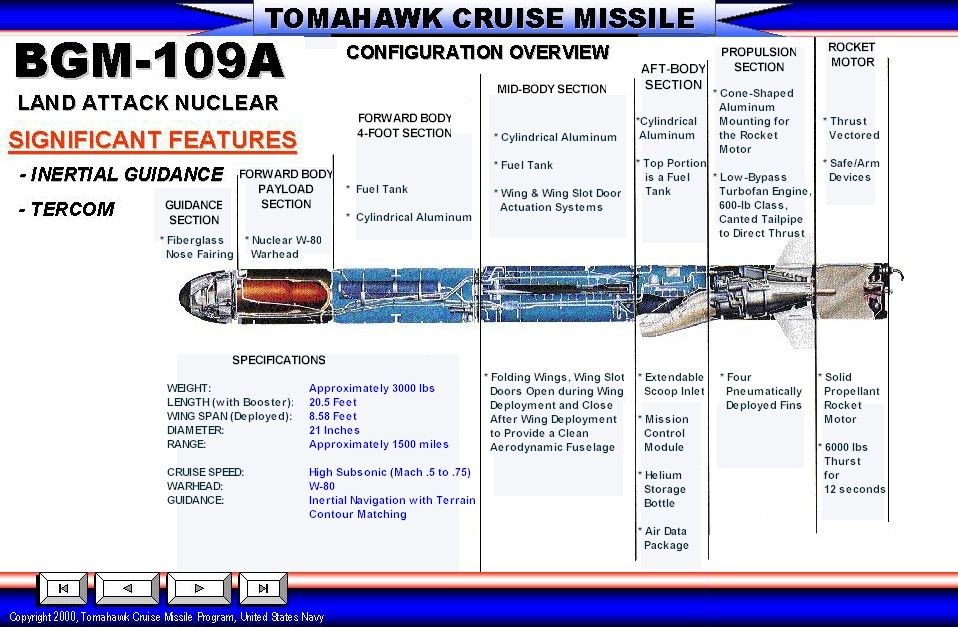
All of these missiles were built around the same basic body and engine, an airframe 18' 3" long and 20.3" in diameter with pop-out wings and a small turbofan engine providing 600-700 lb of thrust. The whole missile weighs somewhere between 2,700 and 3,000 lb, and is boosted into the air by a rocket that is then discarded. The ship and submarine-launched versions of a given type are very similar, differing primarily in their launching mechanism. The submarine-launched versions can be fired out of a torpedo tube, with the missile being ejected and then the booster fired to drive it out of the sea and into the air. Most submarines built since the mid-80s have also been fitted with vertical tubes to give extra Tomahawk capacity. Most attack submarines carry 12, while four of the Ohio class ballistic missile submarines have been converted to fire 7 Tomahawks each from 22 of their missile tubes.
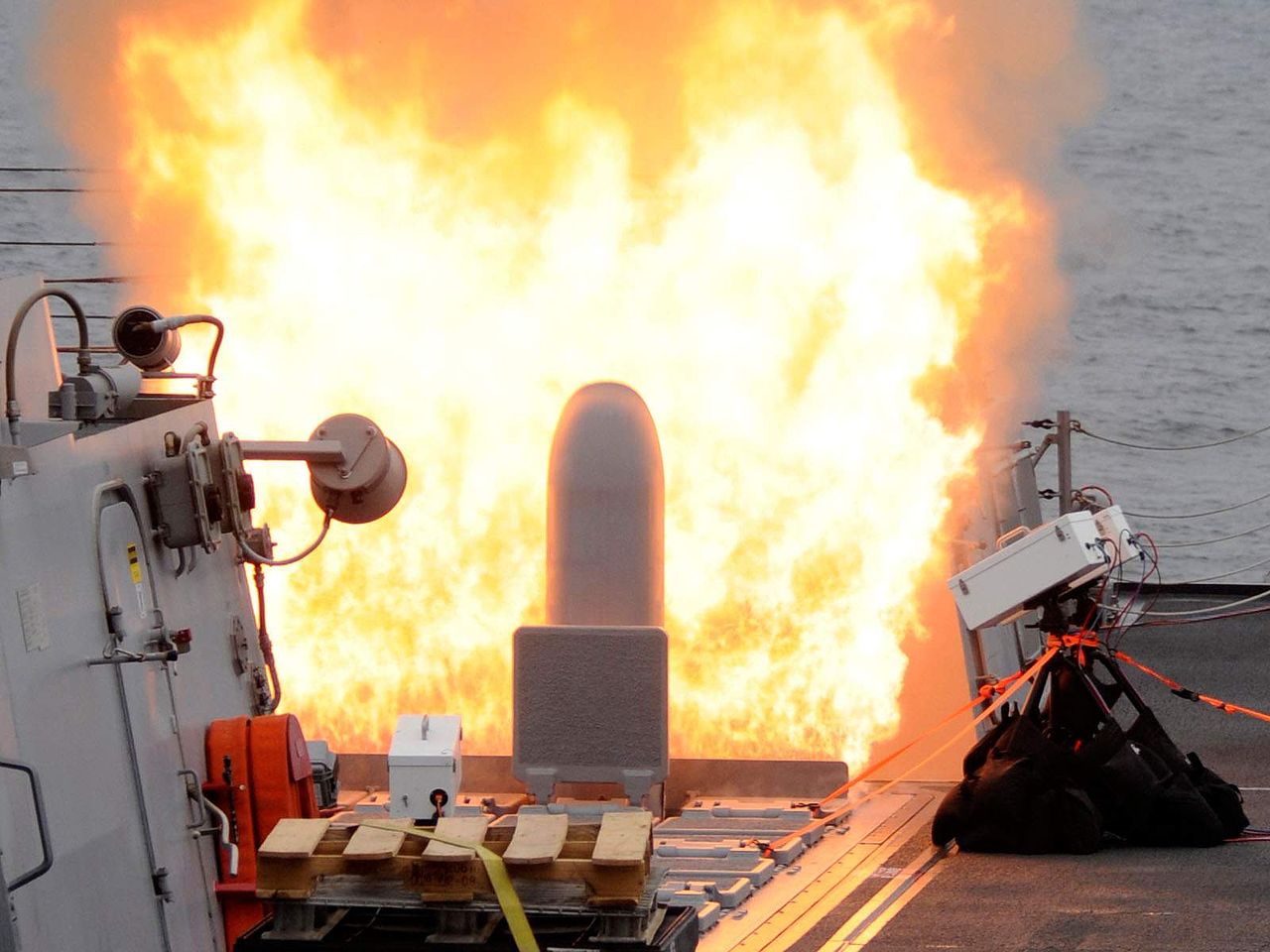
A Tomahawk emerges from the VLS of the destroyer Sterett
The vast majority of surface ship Tomahawks are also launched vertically, using the Mk 41 Vertical Launching System that equips all modern American cruisers and destroyers. The Mk 41 provides unmatched versatility, allowing tradeoffs to be made between land-attack missions, air-defense in the form of Standard and ESSM, and anti-submarine warfare with VLASROC. But VLS didn't go to sea until the late 80s, so another means was needed to give surface ships an interim capability with Tomahawk. Initial plans were for an open rack similar to that used for Harpoon, but the 1975 fire on the cruiser Belknap increased interest in damage resistance, and an Armored Box Launcher (ABL) was developed. It would protect a quartet of horizontally-stored missiles with an inch or so of armor, then open up for launch. The first weapons would go to sea on the destroyer Merrill, which carried two ABLs, followed by the battleship New Jersey, which was fitted with eight when she was reactivated in the 1980s. Her three sisters were also fitted with a heavy Tomahawk battery, and these weapons formed an important part of the rationale for their last stint in service.
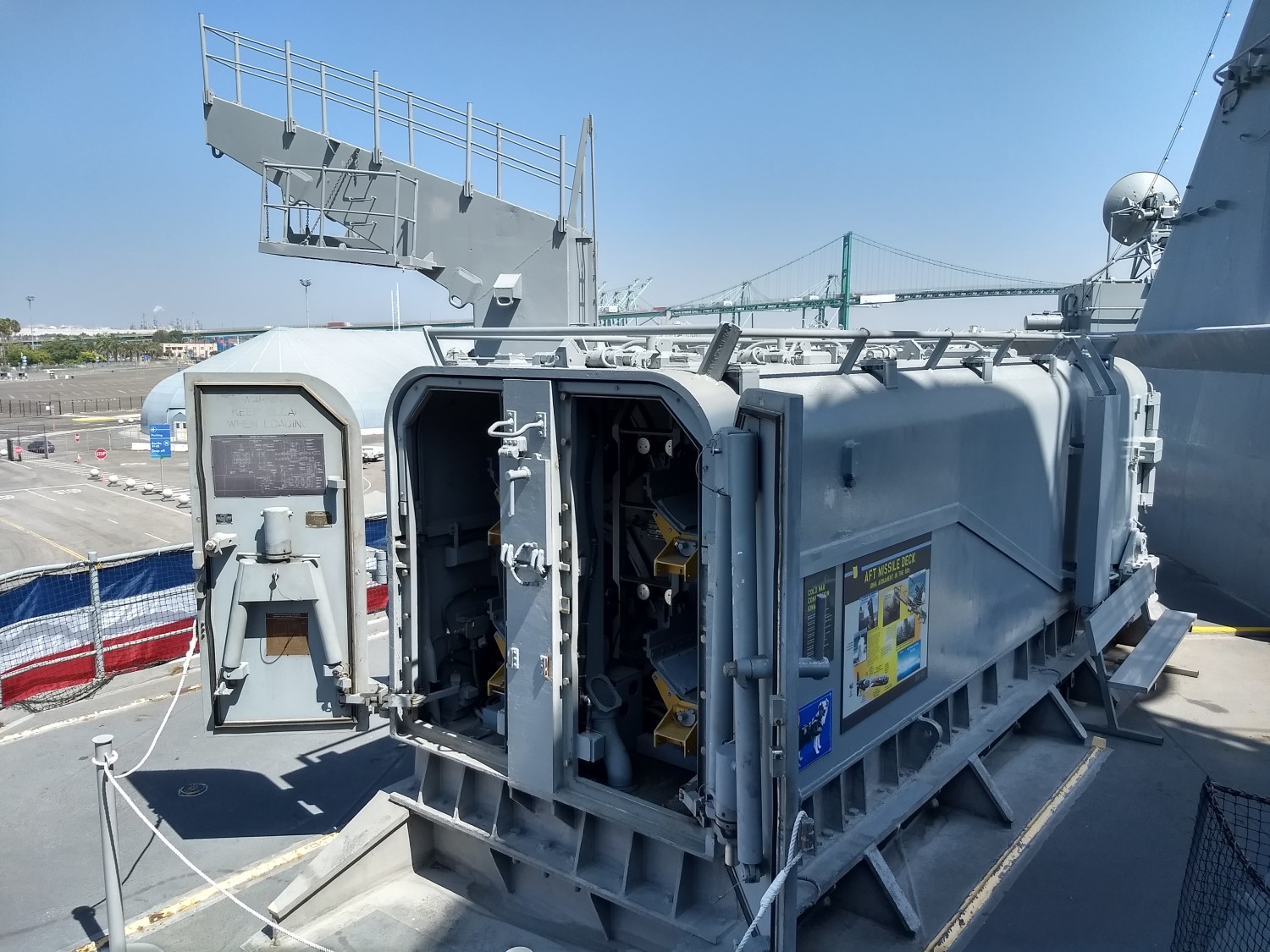
One of Iowa's ABLs, open but not elevated
The TLAM-N was equipped with a W80 nuclear warhead, which has an adjustable yield of either 5 kt or 150 kt.2 After launch, it was inertially guided until it made landfall, where the inertial system was updated by a system called Terrain Contour Matching or TERCOM. This involved a series of digitized elevation maps of specific areas along the missile's trajectory. A radar altimeter would read the ground below the missile, and use this data to figure out where in the terrain map it was. The first maps had large cells, to make it easy for the missile to locate itself, and later ones strung along the flightpath were smaller, giving greater accuracy, with the CEP3 estimated at 50m even at the missile's maximum range of 1,350 nm.
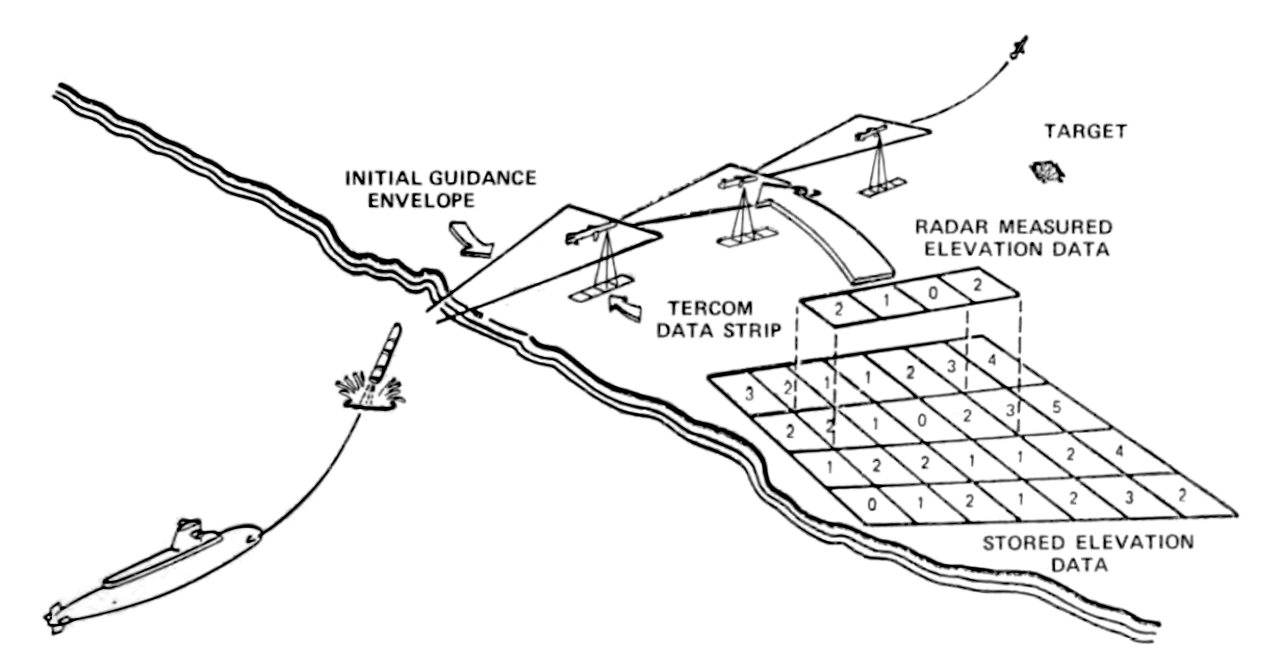
How TERMCOM works
The TLAM-N had immense strategic implications. Before it entered service, only the carriers had the capability to launch nuclear strikes from the sea, and the Soviets had dedicated a lot of resources to tracking and sinking the carriers before they could do so. One cornerstone of this was their ocean surveillance network, which was designed to track a dozen or so vessels at a time. Tomahawk gave any ship or submarine the potential to add to the nuclear striking force, completely overwhelming the Soviet surveillance system. It was not a particularly popular weapon, as any nuclear-capable system had to be guarded at all times as if it was carrying nuclear warheads, increasing the demand on the ship's crews and restricting operations. Ultimately, the TLAM-Ns were withdrawn from shipboard inventories in 1991, along with all other sea-based nuclear weapons except for those aboard SSBNs, but they remained in the US stockpile for another two decades before being retired, and the reintroduction of a nuclear-tipped Tomahawk has been discussed in recent years.
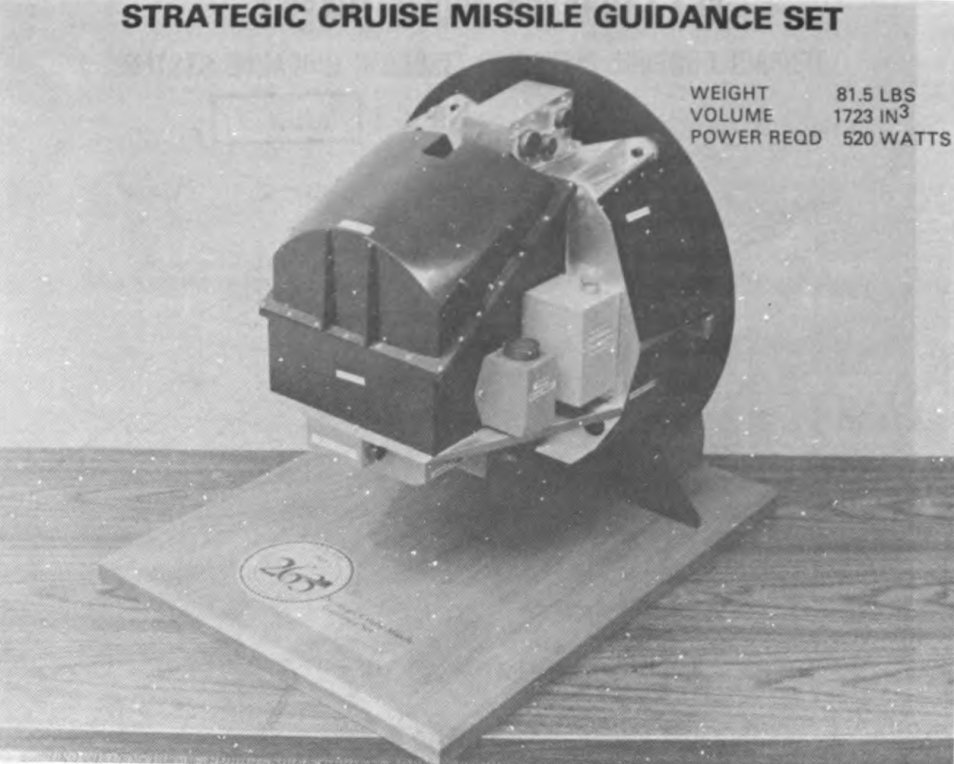
The original TLAM-N guidance set
While the nuclear mission was the impetus to the Tomahawk, it was as a conventional weapon that the Tomahawk has changed the face of naval warfare. And while the land-attack models have gotten all of the headlines over the years, the first of the conventional models was the Tomahawk anti-ship missile. We'll look at it next time.
1 This is the weapon that triggered the well-known protests at Greenham Common. I'm not going to go into detail on it because it's the weird stepchild of the Tomahawk family. ⇑
2 Because these weapons might have to be stored in a submarine torpedo room, which was often used by the crew as an extra space for bunks, the warheads on the TLAM-N used so-called Supergrade plutonium. This is plutonium extracted from fuel rods that have been in the breeder reactor for only a short time, reducing the amount of highly radioactive Pu-240 in the sample relative to the desired Pu-239. ⇑
3 Circular error probable, the radius within which 50% of the weapons are expected to impact. ⇑

Comments
There's something bleakly comical about an arms-control treaty driving the invention of a new type of weapon.
Why was this? Was it to prevent people from figuring out which ships were actually carrying nukes?
Exactly. The USN's longstanding policy is to neither confirm nor deny if its ships are carrying nuclear weapons. (Except for SSBNs, obviously.) Because of New Zealand's anti-nuclear policies and the USN's refusal to say "we have no nukes aboard", no American warship visited New Zealand from 1983 to 2016, and New Zealand got kicked out of ANZUS. They only resumed visits for the 75th anniversary of the RNZN, and so far as I know, the USN hasn't been in New Zealand waters since.
How much of the tomahawk's success should we attribute to its excellent name? I'm thinking at least 1/3. We wouldn't have nearly as many if it was called the loon...
"the booster fired to drive it out of the rocket and into the air" - out of the sea?
Would resuming the deployment of nuclear armed cruise missiles make the use of conventional Tomahawks more risky? The Prompt Global Strike program had a similar problem where a launch might be mistaken for a nuclear attack. Cruise missiles being much slower and stealthier, it might well be the case that their use wouldn't be detected until they were over the target, at which point what sort of warhead they are armed with becomes very obvious. Perhaps this means there wouldn't be a big issue.
A 50m CEP is easily close enough for a nuclear weapon, but sounds significantly larger than a laser guided bomb. Are modern conventional Tomahawks able to deal with bunkers or other hard targets?
@cassander
I don't think that's too much of it. Standard has a terrible name (although it's better than the acronym soup they're using these days) and it's been extremely successful.
@Alexander
Good catch. Fixed.
That's a good question, but I don't think it's nearly as likely. The vast majority of ICBMs are nuclear-tipped, and the concept is heavily linked to nuclear war. We've been using cruise missiles for conventional attacks for decades, so the norms aren't there. After all, nobody freaks out about getting nuked when they see F-16s bearing down on them, even though the F-16 is nuclear-capable.
As for CEP, tune in next Wednesday to find out more...
Semi-fun factoid, the engine for the Tomahawk came from earlier efforts to build jetpacks.
It's actually pretty amazing that the naming system for missiles is very clearly that there is no system. It's as much a programmatic oddity that some do get a name that sticks as anything else. Most other things have a convention (even if it's not always followed [coughcough, LCS) but missiles very clearly don't.
I would have guessed that a big part of why cruise missiles don't induce nuke-panic, although they could well be nuclear armed, is because they are slow enough to see where they are going in time to respond.
If a Tomahawk is launched from the middle of the Mediterranean towards Syria for example, it's pretty obvious that it's heading towards Syria. It COULD make a sudden detour towards Moscow, but it hasn't got the range and it would take hours to get there. There is no reason to be on a hairtrigger. But a ballistic missile heading from Continental USA to Syria could actually be on its way to Moscow, and by the time you've rechecked your data and calculations a couple of time you've now got a few minutes left. As a result it makes people much more twitchy.
If the USA was fighting a war a few minutes flight time from a rival nuke power (cough North Korea cough) then things might be a lot more dicey.
The way that's phrased kinda implies that submarines haven't carried any nuclear weapons for almost thirty years.
Attack submarines have not. Not excluding SSBNs was a mistake on my part, which has now been fixed.
Somewhat fun fact although one pertaining to aviation.
Although I am not sure just how direct an "idea and concept" line can be traced, but in the very late 1990's an engineer at Wright-Patt from one of the project offices described to me how the TERCOM was the seed for the Enhanced Ground Proximity Warning system for aircraft--something that has proven to be an incredible step forward in aviation safety and something I was, at the time, just getting to see displayed.
Obviously they are two quite different systems, but he made the case that what spilled over from the TERCOM design fortunately did not escape the attention of civilian engineers.
Either way, the idea of a terrain database of sorts had been found to be quite life-saving.